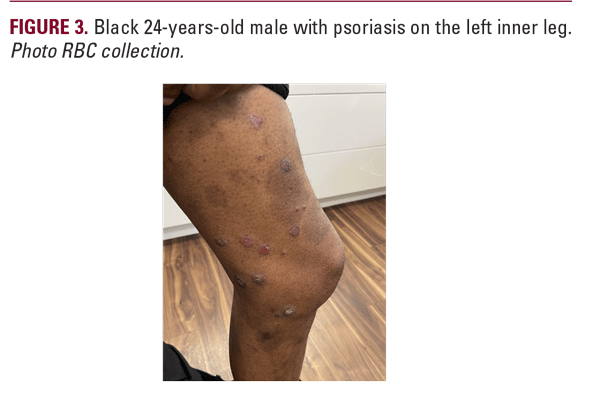
which can be a major concern and may disproportionately affect patients with SOC.4 Another challenge with using PASI as the primary treatment endpoint is that it does not consider QoL in the measurement of disease severity. Psoriasis has been reported to have a greater impact on QoL in patients with SOC.6,18 To accurately reflect the entire burden of disease in SOC patients, treatment endpoints should take into account the broad range of factors that influence QoL, ranging from the physical symptoms of psoriasis to its psychosocial impacts.5,19
Statement 5
Racial/ethnic differences in clinical presentation, sequelae, and the desired treatment outcomes for psoriasis have been reported, particularly post-inflammatory pigment alteration.
Visible manifestations of psoriasis in patients with SOC can go unrecognized by clinicians as plaques in darkly pigmented skin can have violaceous, grayish, or red-brown hues, unlike the salmon pink plaques typical of lighter skin types (Figure 3). These differences may present challenges in differentiating psoriasis from other papulosquamous disorders, leading to misdiagnosis or delayed diagnosis.5 An increased likelihood of undiagnosed psoriasis has been reported in African American individuals,20 which may be influenced in part by persistent racial disparities affecting access to dermatologic care and educational gaps among healthcare providers.
In a survey of 29 leading dermatologists, two-thirds of respondents reported notable clinical differences (including dyspigmentation, thicker plaques, less erythema) in African American patients with psoriasis.21
The prevalence of specific psoriasis subtypes may vary across racial/ethnic populations. In a cross-sectional, patient-reported, physician-reviewed survey from 882 adult and 16 pediatric patients with psoriasis between 2006 and 2016,22 Asian patients and Hispanic/Latino patients had a higher likelihood of having pustular psoriasis than White patients (OR = 4.36 [95% CI: 1.24–17.62], P=.026; OR = 5.94 [95%CI: 1.03–31.03], P= .036, respectively). Asian patients also had a higher frequency of erythrodermic psoriasis (OR = 5.56 [95%CI: 1.41–27.17], P=.018) and a lower frequency of inverse psoriasis compared to White patients (OR = 0.26 [95% CI: 0.06–0.80], P=.036). These findings may be related to racial/ethnic variations in genetic or environmental factors or access to care in the US, but further studies are needed to investigate this question.
In a patient survey (n = 4725) conducted by the National Psoriasis Foundation between 2004 and 2009, a greater psychosocial burden of psoriasis was reported in African American patients, with 72% stating that psoriasis interfered with their capacity to enjoy life versus 54% of White patients.19 Consistent with this finding, African-American patients with psoriasis often have a more severe disease (23% of African American respondents had very severe psoriasis versus 8% of White respondents).
Statement 6
Moisturizers used for psoriasis may help normalize hyperproliferation, differentiation, and apoptosis and have antiinflammatory effects. Moreover, they can reduce scaling and itching, soften cracks, and improve the penetration of topical drugs.
Basic skin care products are well-known for their role in hydration, moisture retention, and symptom control in psoriasis;14 however, these products may be underused.
Published treatment guidance on adjunctive skin care for psoriasis recommends emollients/moisturizers, keratolytic agents, thermal water, and skincare products (eg, gentle cleansers with low pH).8,139,14 Some authors suggest using keratolytic agents in the initial phase of treating psoriasis plaques, switching to moisturizing products and emollients in the intermediate and chronic/remission phase of psoriasis.23
In a study of 30 patients with psoriasis who received a moisturizing cream for 4 weeks, an increase in skin hydration was observed with no change in transepidermal water loss.24 A significant percentage of patients showed skin improvements in desquamation measurements from very dry to dry or normal (P=.0001 for all time points). Two skincare products containing ceramides, salicylic acid, and urea (the first a body cleanser and the second a body cream) showed efficacy in a study of 33 patients with psoriasis.25 Overall improvement in the appearance of the skin was reported in 72.7% of patients with the body cream product alone and 75.8% of patients with the combination regimen of the body cream and the body cleanser. For the combined regimen, 84.8% reported that it provided relief from psoriasis, and 90.9% reported that their skin felt soft and smooth.






